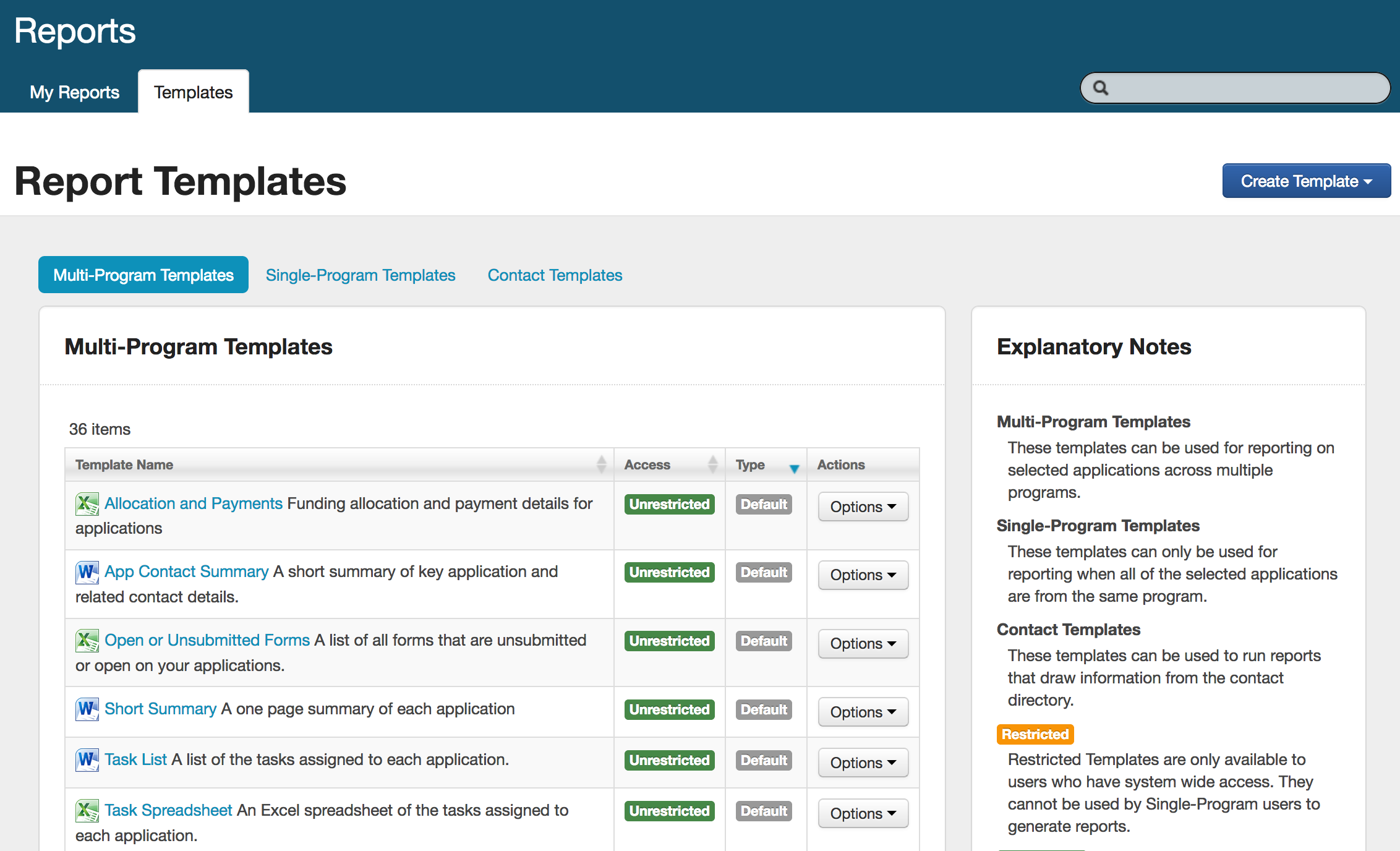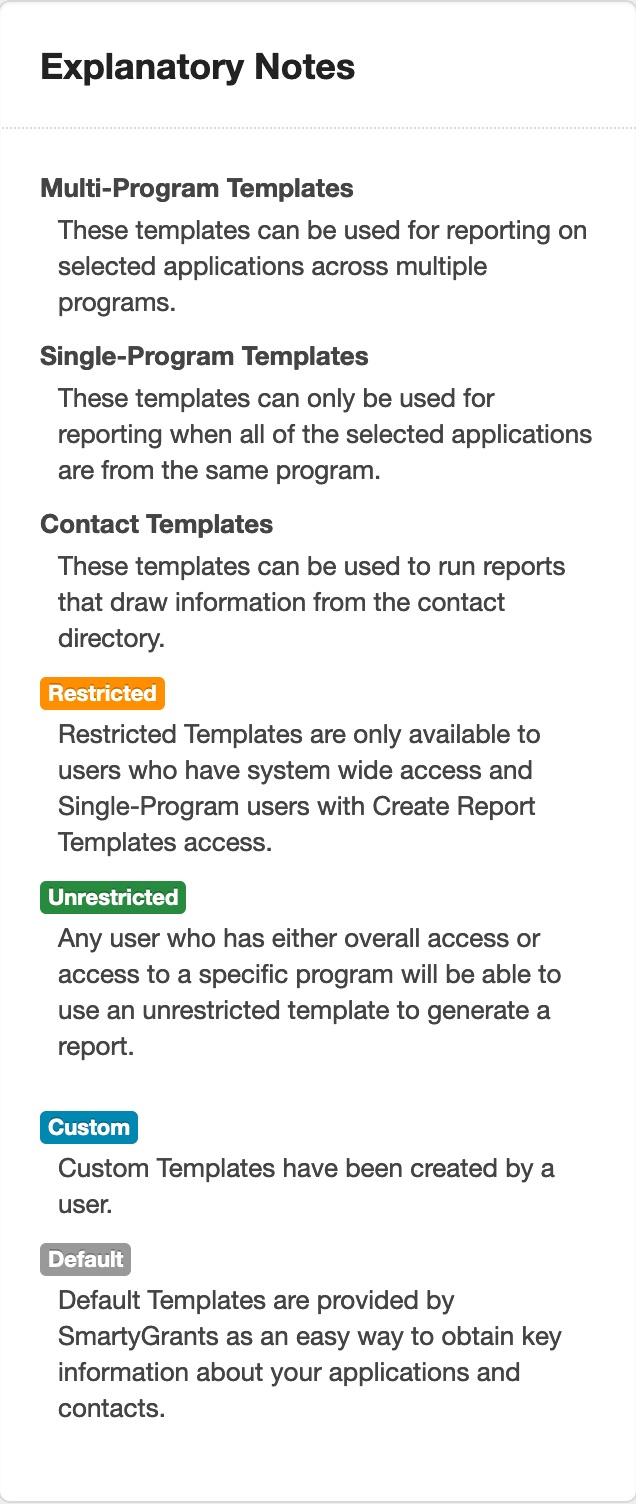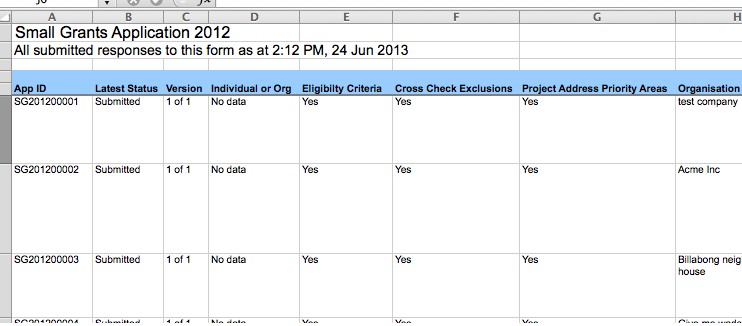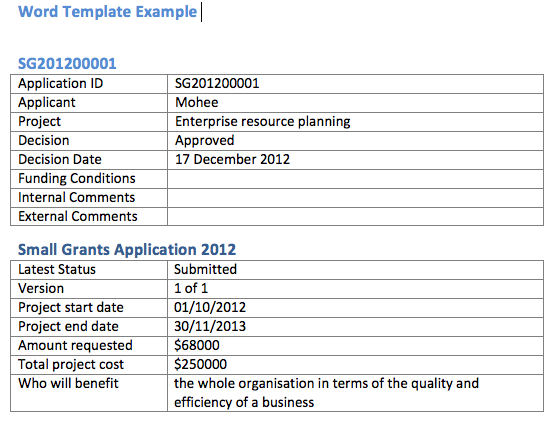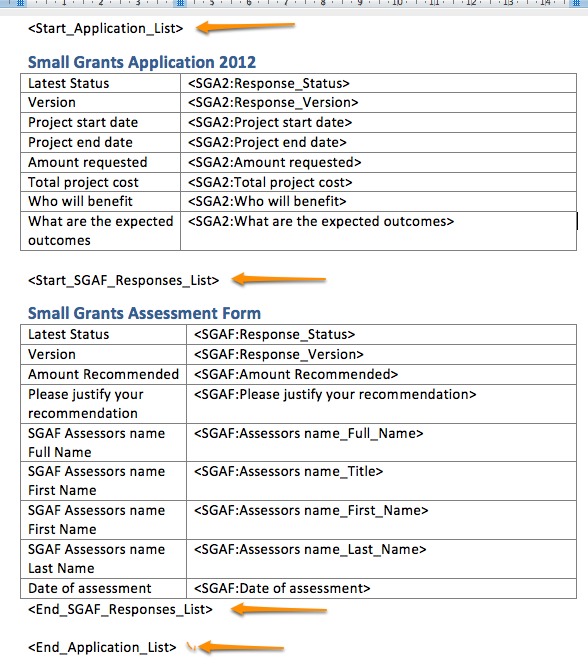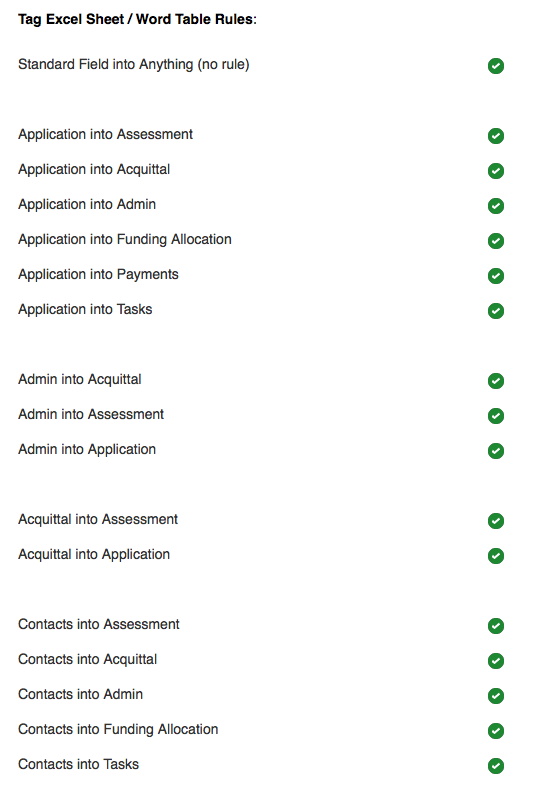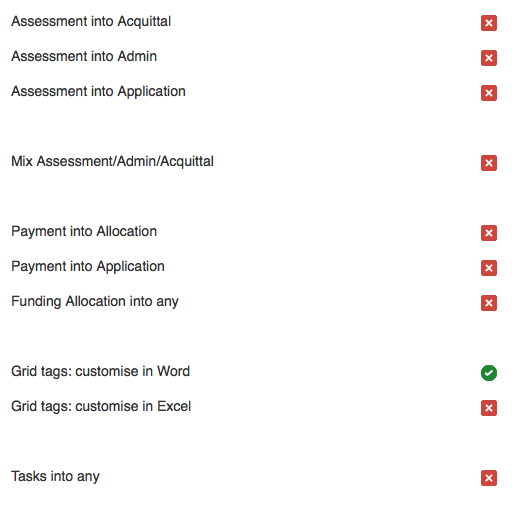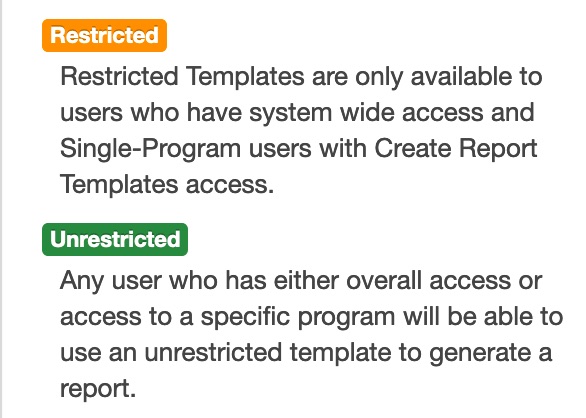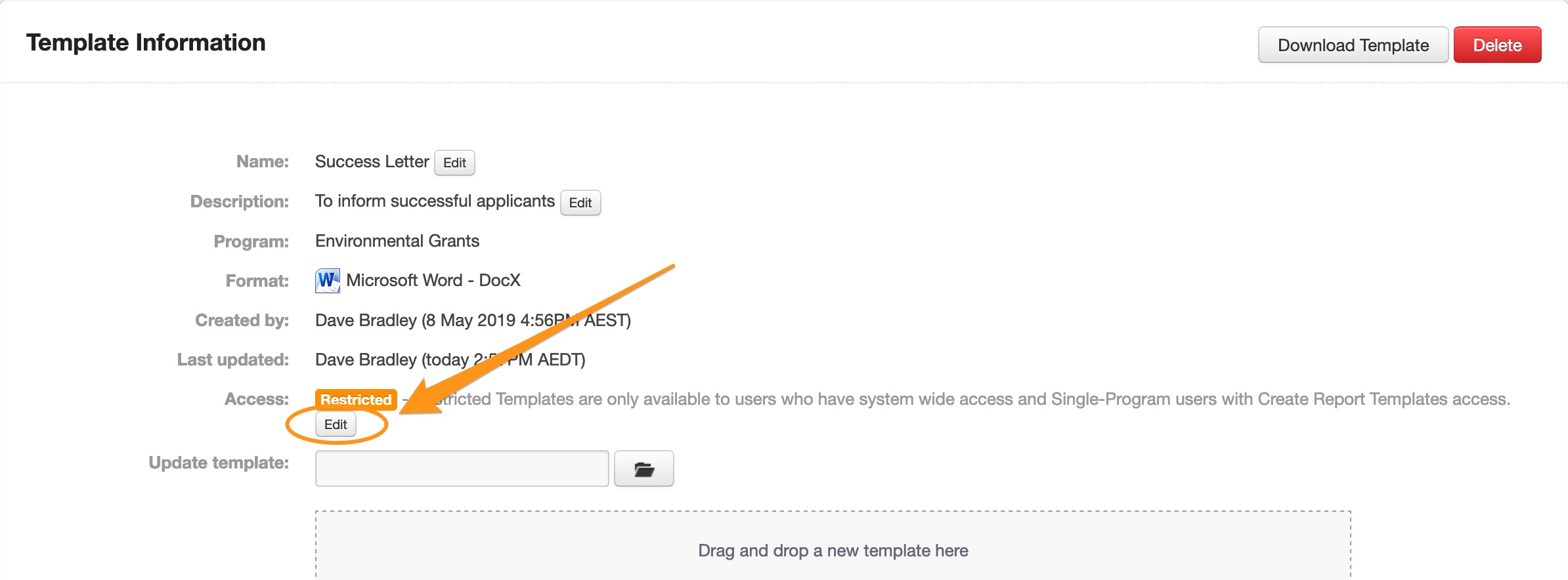Templates and Rules
What are templates and how do they work?
SmartyGrants uses templates to run reports. You are in complete control, so you can pull together whatever data you need into either a Microsoft Word document or Excel workbook. To run a report and extract data you need a template.
Every field recorded in the system can be extracted into a report.
For example, on an application form, every single question asked of an applicant is available for me to specifically include in my template.
Users can select which fields they want included when creating a template, that template can be downloaded and further customised to achieve the desired layout, look and feel.
For example:
For a Notification Letter, you might want individual pieces of data to be inserted into the relevant places throughout a document; much like a traditional mail merge.
For a Council, Committee or Board report, you may wish to create a spreadsheet containing summary information about each application, such as the applicant name, project title, amount requested, and the amount recommended.
You may further wish to stipulate a sort order, text formatting, page headers and footers, inclusion of graphs and so on.
You do this by opening the Template in Word or Excel and manipulating these components as you would when working with a regular document and uploading the customised templates back into SmartyGrants.
Template Types
There are three different types of templates that can be created:
Multi-Program Templates:
These templates can be used for reporting on selected applications across multiple programs. The fields available to include in these templates only include Standard or common fields you would find across all programs.
Single-Program Templates:
These templates can only be used for reporting when all of the selected applications are from the same program. The fields available to include in these templates include fields from forms (Application, Assessment, Acquittal and Administration) specific to a program, this is the only difference compared to a multi-program template.
Contact Templates:
These templates can be used to create reports that draw information specifically from the contact directory. Available fields include any custom contact fields that may have been created.
Template Formats
When a template it created, SmartyGrants will automatically generate the data fields in an automated format (plain Excel spreadsheet or table format in Word).
In the following two examples a template was created asking for specific fields to be included and was not customised any further, a report was then run using the templates generated.
This format may suit your needs, however, users have the ability to customise these templates further.
For example, you may wish to alter the order of the fields, add a logo, amend font, size and colour, page headers and footers, inclusion of graphs and so on. You may also want to use the information to create notification letters.
To customise a template you need to download and amend it in Word or Excel, once customised you can then upload it back into SmartyGrants and then run a report to retrieve the data.
Default Templates
SmartyGrants provides users with a set of formatted Default Templates that may also suit your needs.
You can check them out by running a report and selecting a default template or visit Default Templates Available to see samples.
Customise Templates and Tags
Templates use what are known as 'tags' to retrieve data from the SmartyGrants database. Most of these tags relate to specific fields in the database.
Example:
For example: if you are extracting the Decision recorded against an Application, your template will include the heading 'Decision' and a 'tag' either next to or below the decision heading.
Some additional tags do not relate to specific fields - instead, they help the system retrieve your data.
Start & End Tags
These tags are automatically generated; you may notice them sitting in your 'Column A' in Excel or in Word they will appear at the beginning and end of the relevant tables. This particular code tag is critical to ensuring a report generates successfully. These are referred to as <start> and <end> tags.
Users have the ability to move (copy and paste) tags around in a template to where you want them to appear, as long as they remain between their relevant <start> and <end> tags.
Tags can be copied and pasted from one document to a new one, for example, tags from this template could be copied and pasted into a Successful Letter (similar to how a mail merge would work). The relevant tags wanted and the <start> and <end> tags would need to be copied and pasted as well.
Once this customisation is complete, the document or workbook can be saved and uploaded as a new template or overide an existing one.
Important:
There are rules that apply when customising templates, in particular when trying to include multiple soucres on one tab in excel (for example, assessment and acquital form information) - it is important that users are familiar with these rules before attempting to customise a template (see below).
Template Rules for Customisation
Images | Accepted Image formats: PNG, JPG and GIF. Where can the image be placed? Images can be placed in the main document/spreadsheet area or in the header/footer. Images cannot be used as watermarks. |
Header/Footer | Headers and footers can be edited as usual. Tags cannot be included in a header or footer. |
Bullet/Numbered Lists | These lists should work in compatible versions of Microsoft Word, however, how they appear/work may alter depending on the version of Word being used. To ensure you get lists looking the way you want them to, run a report using the template and test the appearance of the report, then alter the results if necessary in the template. |
Tag Rules | When a template is created, the system will automatically insert tags into the relevant areas of the reporting hierarchy. In the example below, fields were selected from most areas of the system. In Excel, a new worksheet is generated for each separate area of the system fields were chosen from. For example, you can see below that funding allocations, payments, a sheet for each form (any type of form), contact types and tasks was generated. in the example below, some worksheets have a short acronym such as 'SGA2', this is shortened and stands for 'Small Grants Application 2012'). This is how the system automatically generates information, however, this can be customised. For example, you may want tags (information) from the application and assessment form to all appear on the one worksheet. This can be done, but there are rules that must be followed. For example: an 'Application Form' tag can be copied and pasted into an 'Assessment Form' sheet or table, but it cannot be done in reverse (assessment tag into application sheet). The same rules apply in Word, as you can see from the following example. In the example, Assessment Form information sits between its own <start> and <end> tag (<Start_SGAF_Responses_List> and <End_SGAF_Responses_List>). In this example, the tag <SGA2: Project start date> could be copied from the 'Application' table and pasted into the 'Assessment' table and the report would run successfully. However, this cannot be done in reverse (copying the <SGAF: Amount Recommended> tag and pasting it into the 'Application' table - as the 'Assessment' tag/field would end up missing its own <start> and <end> tag). In the above examples we have used application and assessment, however, sets of rules also apply across the following areas: Each of these areas have their own <start> and <end> tags:
The below rules reference the ability for you to include information from the stated sources into the same tab in an excel report and within the same element (for example a table) in a word report. For details on how to make more advanced templates that ignore these rules please see Customise Templates For further information on creating and customising templates see create templates or check out reporting video tutorials. |
Template Access
Users who have 'system wide' access have access to run reports using all templates, however, unrestricted access to report templates can be given to 'Program Specific' users if needed.
Restricted: templates are only available to users who have system wise access and Single-Program users with 'Create Report Templates' access.
Unrestricted: templates can be run by any user who has either overall access to the system or access to a specific program.
To adjust the the access level on a template:
Go to the templates tab in the reporting area and click on the 'options' button next the template you wish to adjust and select 'View Details'.
Select 'Edit' under the access tag, select the relevant access and save.
